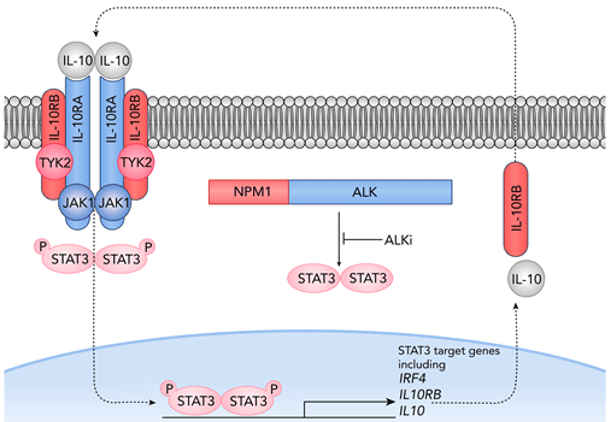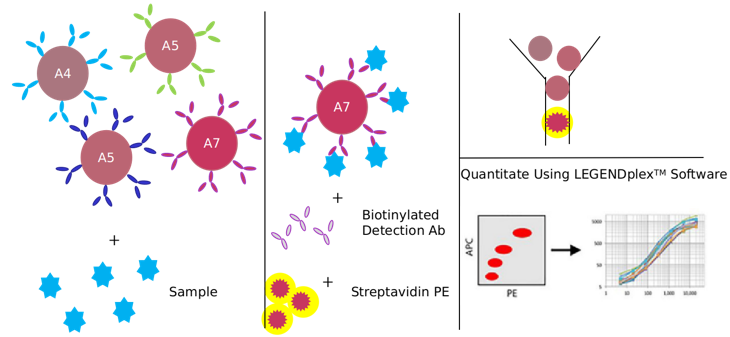Introduction to anaplastic lymphoma kinase signaling pathway
Based on Luminex technology platform, Creative Proteomics provides analysis services for key targets of anaplastic lymphoma kinase signaling pathway.
 Anaplastic lymphoma kinase (ALK), aka CD246, is a tyrosine kinase receptor encoded by the ALK gene located on chromosome 2p23.2-p23.1. Commonly used monoclonal antibodies to ALK include the clones 5A4 and D5F3. IHC for ALK may be used for the analysis of Spitz tumors, since they may be associated with ALK-rearrangement and overexpression. Spitz tumors expressing ALK tend to be amelanotic and display a growth pattern of intersecting fascicles. ALK expression may also be seen in a small subset of primary and metastatic melanomas, where it is usually associated with the presence of a truncated ALK isoform. IHC for ALK may be used as a screening method to identify rare ALK-positive melanomas to select patients for treatment by ALK inhibitors.
Anaplastic lymphoma kinase (ALK), aka CD246, is a tyrosine kinase receptor encoded by the ALK gene located on chromosome 2p23.2-p23.1. Commonly used monoclonal antibodies to ALK include the clones 5A4 and D5F3. IHC for ALK may be used for the analysis of Spitz tumors, since they may be associated with ALK-rearrangement and overexpression. Spitz tumors expressing ALK tend to be amelanotic and display a growth pattern of intersecting fascicles. ALK expression may also be seen in a small subset of primary and metastatic melanomas, where it is usually associated with the presence of a truncated ALK isoform. IHC for ALK may be used as a screening method to identify rare ALK-positive melanomas to select patients for treatment by ALK inhibitors.
Anaplastic lymphoma kinase was first described in 1994 as the NPM-ALK fusion protein that is expressed in the majority of anaplastic large-cell lymphomas. ALK is a receptor protein-tyrosine kinase that was more fully characterized in 1997. Physiological ALK participates in embryonic nervous system development, but its expression decreases after birth. ALK is a member of the insulin receptor superfamily and is most closely related to leukocyte tyrosine kinase (Ltk), which is a receptor protein-tyrosine kinase. Twenty different ALK-fusion proteins have been described that result from various chromosomal rearrangements, and they have been implicated in the pathogenesis of several diseases including anaplastic large-cell lymphoma, diffuse large B-cell lymphoma, and inflammatory myofibroblastic tumors.
The EML4-ALK fusion protein and four other ALK-fusion proteins play a fundamental role in the development in about 5% of non-small cell lung cancers. The formation of dimers by the amino-terminal portion of the ALK fusion proteins results in the activation of the ALK protein kinase domain that plays a key role in the tumorigenic process. Downstream signaling from ALK fusion proteins involves the Ras/Raf/MEK/ERK1/2 cell proliferation module and the JAK/STAT cell survival pathway. Furthermore, nearly two dozen ALK activating mutations participate in the pathogenesis of childhood neuroblastomas along with ALK overexpression. The occurrence of oncogenic ALK, particularly in non-small cell lung cancer, has generated considerable interest and effort in developing ALK inhibitors.
Chromosomal rearrangements in the ALK gene have been identified as oncogenic drivers of non-small cell lung cancer (NSCLC). The ALK signaling pathway plays an important role in lung cancer. Understanding the ALK signaling pathway in lung cancer will provide a roadmap for the management of major epithelial malignancies driven by receptor tyrosine kinase rearrangements.
Our detectable targets:
| JAK1 | BID | IAPs | TLR3 | SODD | Bad |
| TYK2 | Bax | PIDD | MYD88 | Rac1 | TLR4 |
| STAT3 | RIP1 | TRAF-2 | FADD | APAF-1 | BID |
| IL-10RA | IRF7 | Mda-5 | NFκB | RIG-1 | TRAF3 |
| IL-10RB | IRF9 | MEKK1 | p38 | RIP1 | TRAF5 |
| IL-10 | IRS1 | MEK6 | p50 | SLP76 | TRAM |
| ALK | IRS2 | MSK1 | p65 | Tak1 | TRIF |
| NPM1 | ISGF3 | MSK2 | PI3K | TBK1 | Vav |
| IRF4 | ISRE | mTOR | PKR | TLR3 |
Technology platform:
We provide Luminex technology for anaplastic lymphoma kinase signaling pathway analysis.
Luminex technology is a multifunctional liquid phase analysis platform developed on the basis of colored microspheres, laser technology, applied fluidics and high-speed digital signal processing technology. The core is to encode polypropylene microspheres or magnetic microspheres with fluorescent dyes. By adjusting the different ratios of the two fluorescent dyes, up to 100 microspheres with different fluorescence spectra can be obtained. Antigen-antibody, enzyme-substrate, ligand-receptor binding reactions and nucleic acid hybridization reactions are performed on microspheres with different fluorescence encoding. Qualitative and quantitative analysis by laser detection of microsphere coding and reporter fluorescence separately.
Anaplastic lymphoma kinase (ALK) is named after it is found in anaplastic large cell lymphoma (ALCL). It is a receptor tyrosine kinase that belongs to the insulin receptor superfamily and is specifically expressed in adult brain tissue The ALK gene targeted therapy drug has achieved good results in the treatment of a variety of tumors.
In addition to Luminex Multiplex Assay, Enzyme-linked immunosorbent assay (ELISA), Flow cytometry (FACS analysis) technology can also be provided to meet other customer needs.
Advantages of anaplastic lymphoma kinase technology:
- High-throughput and high-speed: Each microsphere is used as a separate test body, which can perform a large number of biological tests at the same time. It only needs 10~201 samples to test up to 100 indicators at a time, and the fastest can reach 10,000 tests /hour.
- Good repeatability: The Luminex detection platform directly reads the fluorescence value, which is more stable and sensitive: 100 microspheres of each type are detected, and the median value is taken as the result, which is equivalent to 100 repeated detections for each sample.
- Low cost: Simultaneous detection of multiple indicators of a sample can save time, samples, reduce detection costs, and improve analysis efficiency.

Application of our service:
- To study the regulation mechanism of anaplastic lymphoma kinase signal pathway in disease
- To study the effect of each virus on anaplastic lymphoma kinase signaling pathway
- To study the effects of drugs or therapies on anaplastic lymphoma kinase signaling pathways
Creative Proteomics has developed a signal pathway target detection platform. We are not limited to providing anaplastic lymphoma kinase signal path detection services, but can also provide other signal path detection services. If you want to detect other targets, please contact us and we will customize the service for you. Look forward to working with you.
References:
- Lovly, C., McDonald, N., et al. Rationale for co-targeting IGF-1R and ALK in ALK fusion–positive lung cancer. Nat Med, 2019, 1027-1034.
- Chiarle, R., Voena, C., et al. The anaplastic lymphoma kinase in the pathogenesis of cancer. Nat Rev Cancer, 2018, 8: 11-23.



